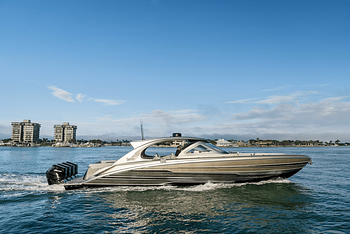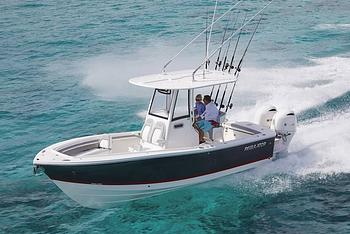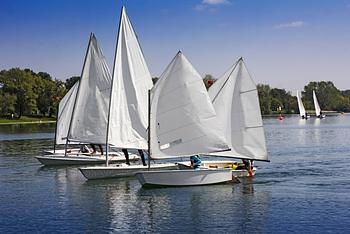- What is a blue water sailboat?
- What to look for when choosing a cruising sailboat under 40 feet?
- What are the advantages of small blue water sailboats?
- What are the disadvantages of small sailboats?
- Best blue water sailboat models under 40 Feet
What is a blue water sailboat?
The term blue water sailboat doesn’t refer to a specific style of boat in the same way that a ketch or schooner does. In fact, a blue water sailboat could be either of those and many more. But when we talk about blue water sailboats, they have shared characteristics that make them suitable for, you guessed it, blue water sailing. Making long, open sea voyages such as crossing the oceans requires a boat that is solidly-built and can tackle heavy seas and inclement weather conditions. Blue water sailboats are able to be self-sufficient and lived on for extended periods of time, and to offer safety and comfort.
In a previous guide we looked at the different types of sailboats, focusing on identifying them by their hull type, rigging and uses. In general, smaller blue water sailboats under 40 feet tend to be cutters, sloops or ketches. Catamarans and trimarans too are becoming increasingly popular as long cruising vessels, although these tend to be larger than 40 feet. In fact, while there are manufacturers producing some excellent, sturdy and compact blue water sailboats under 40 feet, they tend to be a minority and most ‘small’ sailboats designed for long-range cruising are usually above 50 feet.

What to look for when choosing a cruising sailboat under 40 feet?
So what other characteristics should you be looking for in a small ocean sailboat?
Construction:
The material of the hull is probably the most crucial aspect, as it needs to be solidly built and able to withstand harsh seas as well as any collisions with floating objects. Hulls made from steel, strong fiberglass or carbon fiber tend to be the most popular. With a brand new sailboat you can be assured of a sound hull, however when buying a used sailboat under 40 feet the most important aspect is to ensure that the hull is strong and durable.
Keel:
The type of keel also makes a big difference, as deep V hulls with an encapsulated keel will make your boat less likely to capsize or lose its keel. Keel sailboats under 40 feet with skeg-hung rudders are considered the best small sailboats for open ocean cruising. While in the past it tended to only be monohull boats which were used for blue water sailing, there are now several manufacturers offering catamarans and trimarans which are strong enough to cross oceans.
Rig:
While the rig itself doesn’t necessarily denote whether a sailboat is more blue water worthy, it needs to be able to be manned by the number of crew on board as well as less crew if anyone is injured. The most important aspect is to think of the manageability of the rig.
Cockpit:
Ocean-going sailboats tend to have small cockpits to keep water out. While traditionally they used to have an aft cockpit there are more center cockpit blue water sailboats around these days. They need to have good drainage as well as offering the helmsman easy reach of the headsail, staysail and mainsail sheets.
Self-steering:
Whether you’re sailing solo or with a small crew, having the ability to set an auto-pilot is an important characteristic of a blue water boat. From tiredness to accidents or illness, there might come a time when you need to set the autopilot when under power or windvane when under sail.
Interior:
A compact cabin, galley and head with plenty of handholds and safe storage are vital to spending long stretches of time at sea. There needs to be enough space to ensure you are able to be self-sufficient for long periods of time. This includes everything from provisions to safety equipment, power systems, water makers, fuel storage and two anchors.
Ability to heave-to:
The act of heaving-to involves pointing the bow into the wind and fixing the helm and sail positions. This essentially stops the boat in the water and is a hugely important maneuver during storms to prevent capsizing and allows the crew to take shelter inside. Some sailboats are more able to perform this than others.
Safety:
Having a way to communicate an emergency is vital, and your blue water sailboat should have a satellite phone and radio installed. A radio will allow you to connect with passing vessels, while the satellite phone is your only means of true contact with land. On deck, safety is paramount, and additions such as granny bars by the mast, safety rails and of course a harness mean you’ll be staying on board in lively conditions.
Ability to Store or Make Water:
Water water everywhere and not a drop to drink is not a phrase any sailor wants to utter. So it’s imperative that your sailboat has enough storage capacity for long voyages, as well as the ability to make fresh water for drinking and washing in. Consider that two people on a three week voyage will require around 50 gallons of fresh water (allowing for a 20% contingency). Space – and weight considerations - is always a premium on small sailboats, so you need to make sure there are enough water tanks. You’ll also want a water maker which are powered by motors and generators. AC water makers can produce around 20 gallons a day, while DC water makers which use a lot less power, produce around 12 gallons of water a day.
Good Navigation Systems:
Ok, we’re going to say how important navigation systems are on your boat, and that’s true, but in fact you don’t want to reply on electronic navigation systems alone if you’re out in the middle of the deep blue. Having paper charts on board (in digital format preferably to save on space in a small boat) and knowing how to navigate using them is imperative.

What are the advantages of small blue water sailboats?
There are thousands of models of liveaboard sailboats under 40 feet on the market, but certainly not all of them are suitable for crossing oceans. We’ve seen the general characteristics of what to look for when choosing a blue water sailboat, but what are the pros and cons of a smaller boat versus a larger model?
Affordability:
Smaller tends to mean cheaper and so affordability is a major factor when buying a blue water sailboat. Whether you’re in the market for a new or used blue water sailboat under 40 feet, there are some excellent deals to be found. It means that long-held dream of sailing across the world can happen now, rather than saving for years. The other bonus is that smaller, simpler pocket cruisers will be cheaper and easier to maintain.
Easier to Sail:
The simpler the rig and the less systems on board the easier the boat will be to sail (and to care for). You’ll need a smaller crew meaning cruising boats under 40 feet tend to be popular with couples and solo sailors.
What are the disadvantages of small sailboats?
Less Spacious:
It goes without saying that smaller boats have less space. While manufacturers are finding ever-more ingenious ways to equip small sailboats with everything their larger counterparts have – and there are some clever ways you can maximize storage space in a boat – realistically space will be at a premium, meaning the number of crew and the amount of comforts you can have on board will need to be minimal.
They Tend to be Slower:
As a general rule, the smaller the sailboat, the slower it will be. While this isn’t always a bad thing if you’re in no hurry to get anywhere, it’s worth considering that out-running bad weather can be trickier in a small boat.
Less comfortable:
A smaller boat can make for a less comfortable ride, especially in bigger seas.
Best blue water sailboat models under 40 Feet
If you’re in the market for a cruising sailboat under 40 feet the options can seem dizzying. With so many to choose from it’s hard to know where to start. There are thousands of excellent used boats on the market, with reputations for reliability, safety, comfort and build. Here however we’re going to take a look at some of the manufacturers making the best bluewater sailboats in 2023. With a solid reputation and excellent craftsmanship, they make a good place to start your search.
-
Beneteau’s Oceanis 40, Oceanis 38.1 and Oceanis 34.1.
Beneteau’s reputation shines through in this smaller range of ocean-going yachts. At the top end of the under-40 foot range is the Oceanis 40, with a hull designed by Marc Lombard and a huge amount of deck and interior space for its size. The Oceanis 38.1 offers surprising comfort and speed, with the ability to be sailed with a small crew, while the smallest in the range is the Oceanis 34.1 pocket cruiser, with cleverly designed spaces and a modern hull design.

Photo credit: Beneteau
-
Jeanneau’s Sun Odyssey 349 and Sun Odyssey 380:
For over 60 years Jeanneau has been crafting motor and sailboats which push the boundaries and the Sun Odyssey range is the perfect example of that. The Sun Odyssey 349 and Sun Odyssey 380 are the smallest in the range, offering high performance sailing you would expect of a much larger model. With an iconic inverted bow, huge interior spaces and fine-tuned handling, they are popular models for long distance cruising.

Photo credit: Jeanneau
-
Hallberg-Rassy 340, 372, 40 and 40C:
The range of Swedish-built Hallberg-Rassy small blue water yachts is one of the most impressive of any manufacturer. Boasting four yachts under 40 feet, they put their nine decades of expertise into both center cockpit and aft cockpit ocean-going cruisers and have the awards to show for it. From the Hallberg-Rassy 340, which manages to pack everything you could need in a long-range cruiser into an ultra-compact package, to the award-winning 372 which manages to be even faster than the already fast Hallberg-Rassy 40. They offer incredible handling, expansive oak interiors, generous cockpits and modern rigs.

Photo credit: Hallberg-Rassy
-
SeaWind Catamarans’ 1160, 1190 and 1260:
It’s uncommon to find blue water catamarans under 40 feet, but SeaWind has crafted no less than three compact, sturdy cats that can cross oceans in safety and comfort. With huge interior spaces across its double beam, you get much more living space than you would in a monohull of the same size, as well as robust seaworthiness, great sailability and all at an attractive price.

Photo credit: SeaWind
Related Articles and Guides
19th Jul 2024
The World’s Best Yacht Brands
12th Jul 2024
Top Performance-Boat Brands, Where There’s Something For Everyone
28th Jun 2024
Best Center Console Boats: The Best Brands Across the Spectrum
23rd Jun 2024






